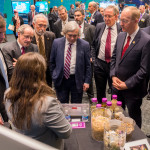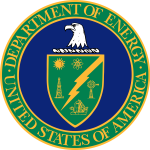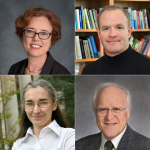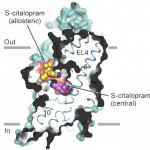 Staff members from across the Department of Energy’s national lab network helped convey the contributions of the national laboratories to Congressional members and staff during National Lab Science Day. The event was held Wednesday, April 20, in the Dirksen Senate Office Building on Capitol Hill in Washington, D.C.
Staff members from across the Department of Energy’s national lab network helped convey the contributions of the national laboratories to Congressional members and staff during National Lab Science Day. The event was held Wednesday, April 20, in the Dirksen Senate Office Building on Capitol Hill in Washington, D.C.
Biosciences Area Participates in DOE’s Big Ideas Summit
 On April 21 and 22, 2016, the Department of Energy (DOE) hosted the National Laboratory Big Ideas near Washington, D.C. The Summit was the third annual gathering to elicit large-scale, potentially game-changing ideas from DOE’s 17 national laboratories working collaboratively to tackle the nation’s energy and science challenges. A theme of this year’s Summit was the Presidential Mission Innovation initiative to dramatically accelerate global clean energy innovation to address climate change.
On April 21 and 22, 2016, the Department of Energy (DOE) hosted the National Laboratory Big Ideas near Washington, D.C. The Summit was the third annual gathering to elicit large-scale, potentially game-changing ideas from DOE’s 17 national laboratories working collaboratively to tackle the nation’s energy and science challenges. A theme of this year’s Summit was the Presidential Mission Innovation initiative to dramatically accelerate global clean energy innovation to address climate change.
Biosciences Scientists Elected to the American Academy of Arts and Sciences
Four Berkeley Lab scientists have been elected to the 2016 class of the American Academy of Arts and Sciences, a 236-year-old honorary society that recognizes accomplished scholars, scientists and artists in academia, the humanities, arts, business and government. They include Biosciences’ biophysicist senior scientist Robert Glaeser and biophysicist senior faculty Eva Nogales of the Molecular Biophysics & Integrated Bioimaging Division; and Jay Keasling, Biosciences associate laboratory director and CEO of the Joint BioEnergy Institute. Together with the Lab’s Nuclear Science Division Director Barbara Jacak, they are among 213 new members announced by the academy today (April 20).
Founded in 1780, the American Academy of Arts and Sciences is one of the country’s oldest learned societies and independent policy research centers, convening leaders from the academic, business, and government sectors to respond to the challenges facing—and opportunities available to—the nation and the world. Members contribute to academy publications and studies of science, engineering, and technology policy; global security and international affairs; the humanities, arts, and education; and American institutions and the public good. The new academy members will be inducted at an October 8 ceremony in Cambridge, Mass. Read more at the Berkeley Lab News Center.
DOE JGI Helps Improve Cassava Breeding Strategies
For nearly a billion people around the world, cassava is a staple crop and a primary source of calories. The plant is easy to cultivate – cuttings grow well on marginal land—and it is very tolerant of drought. For the U.S. Department of Energy, these traits and its starchy qualities make cassava of interest as a potential feedstock for biofuel production. Though cassava is easy to cultivate, it is particularly vulnerable to plant pathogens, which can significantly reduce crop yields. To help improve breeding strategies for this root crop, a UC Berkeley-led team including DOE Joint Genome Institute researchers have described cassava’s genetic diversity in the April 18, 2016 advance online publication of the journal Nature Biotechnology. Read more about this analysis on the DOE JGI website.
Visualizing Transporter Structure Creates Platform for Antidepressant Drug Design
Researchers at Oregon Health and Sciences University’s Vollum Institute have revealed the molecular structure of the serotonin transporter (SERT), providing new insight into the mechanism of antidepressant action of two widely prescribed selective serotonin reuptake inhibitors (SSRIs) commonly used to treat depression. In their Nature paper, authors Jonathan Coleman, Evan Green, and Eric Gouaux describe their use of X-ray crystallography to capture images of human SERT structures. They collected data at the Beamline 5.0.2 in the Berkeley Center for Structural Biology and used the Phenix software suite to build models and refine the structures. The resulting structures show antidepressants citalopram and paroxetine lock SERT in an outward-open conformation, directly blocking serotonin binding. Visualizing this structure provides a blueprint for future drug design to treat anxiety and depression. This work was highlighted by Nature News and OHSU News.
- « Previous Page
- 1
- …
- 188
- 189
- 190
- 191
- 192
- …
- 213
- Next Page »
Was this page useful?






